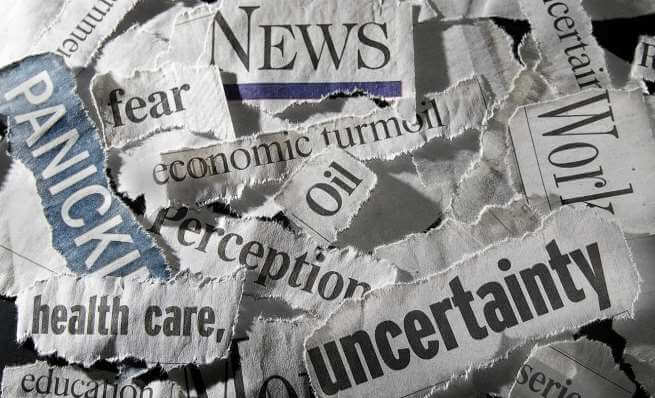Is the economy stumbling, or is this business as usual?: The US economy has failed to improve over recent months. And at the same time, the Australian economy is slowing due to weakness in Asia. This begs the question of whether or not a Recession is just around the corner? Investors certainly are starting to panic.
US Federal Reserve chairwomen Janet Yellen released the Federal Open Market Committee (FOMC) monthly statement on Wednesday, downgrading their view for the US economy. Over the last year, the FOMC has hinted towards a point in time when they would raise Interest Rates, which has caused the US Dollar to rise substantially. But the world’s benchmark currency has started falling as it becomes more apparent that an interest rate rise is not likely any time soon.
Globally, the economic picture is not very rosy.
- Despite the problems stemming from Greece, the Eurozone remains in a weak state with latest figures showing a 0.9% annual GDP growth rate. This had been negative up until late 2013, clawing its way out of a Recession. Inflation has been negative for the last few months, reflecting a contracting economy.
- With the strongest annual GDP growth rate of any nation in the world, China is still considered to be in trouble. Over the last year, we have seen a decrease from 7.9% to 7.0%. The impact to major trade partners is clearly evident.
- Japan has been fluctuating between Recession and weak growth for years. In the latest quarterly report, the economy has clawed its way back to growth at 0.4% annual GDP growth rate. At the same time, Inflation at 2.2% (having declined from 3.7% in May 2014) means the Real rate of growth remains negative.
- The US has found mild improvement in their annual GDP growth rate over the last 2 years, improving from a low of 1.6% to 3.0%. Working in its’ favour is deflation (declining cost of goods) and a slow decline in the Unemployment rate which is currently at 5.5%. However, without some Inflation, the economy is not growing.
- Closer to home, Australia has shown very little growth in the last few years. Recent data shows an annual GDP growth rate of 0.5%. Inflation has more than halved in the last 6-months to 1.3%, but Unemployment remains high at 6.1%
Australia’s major trade partners are suffering from stagnating economies with very little growth prospects. Although China continues to grow, our Mining sector is already feeling the pinch. Add to this the sharp decline in commodity prices and our leading Mining companies are not making the same profit margins as during the boom of the last few years.
Banks are quite highly valued at the moment, and some would consider they are inflated above their fair value. This has helped trigger a sell-off this week on the ASX200, which has dropped nearly 200 points (or +3.0%) in just 2 days.
Analysts are now discussing what opportunities lie ahead.
Following the GFC of 2007/08, the US economy had experienced growth on the back of years of Quantitative Easing (QE), or stimulus measures. With that program ending last year, the economy has failed to improve substantially. In essence, it is failing to improve on its own two feet. And without any additional reason for economic improvement, may require further stimulus to start growing again.
Europe and Japan have recently adopted QE programs in an effort to boost their economies. This should reflect how desperate they are for growth. Through the US QE programs, it has been proven that this does help the economy, but must be continued until such time that the economy can independently grow on its own. And how long will that take?
Australia, on the other hand, has been heavily reliant on the growth of China in recent years. Now that this boom has come to an end, the government is undergoing campaigns to create new industry income through fields such as Medical knowledge and technology.
Where to from here?
The Reserve Bank of Australia (RBA) is scheduled to release their Interest Rate statement on Tuesday 5th May. The probability of an interest rate cut has improved, especially on the back of weaker economic data. This would help stimulate the economy slightly, but will it be enough to create confidence amongst investors?
Not likely. Investors are bunkering down for some hefty headwinds. Our major trade partners are China, US and Japan. None of these economies are performing particularly well. And without that to help boost our trade exports, we are not likely to be able to create new prosperity internally.
There are some hard roads ahead for investors. The Australian Stock Exchange (ASX), as represented by the ASX200 index has hit 6,000 points 4 times since late February. This has formed a trading range or consolidation period.
ASX200 highs and lows…
For the first half of this week, we have seen the ASX200 retrace from those highs to the medium-term lows, quickly and without any hesitation. This has some investors worried. But an Interest Rate drop next Tuesday will help boost investor confidence, slightly. Which might, help arrest a decline in the markets.
However, if we find rates are kept on hold next Tuesday, this could send the stock market lower. As long as investors don’t ‘panic sell’, we could ride through any mild market decline.
On a positive note, there was confidence earlier in the year, driving the ASX200 up more than 13% in February/March. If we have a market retracement in coming weeks, this could be viewed as a more effective accumulation level for stocks, which have probably been Overbought. That could lead to a more promising finish to the year.
In essence, investor confidence is stumbling a little, but it is not panic stations just yet. Slow growth is expected on the short-term, but in the meantime, it is business as usual.
To learn more about these strategies click here.

